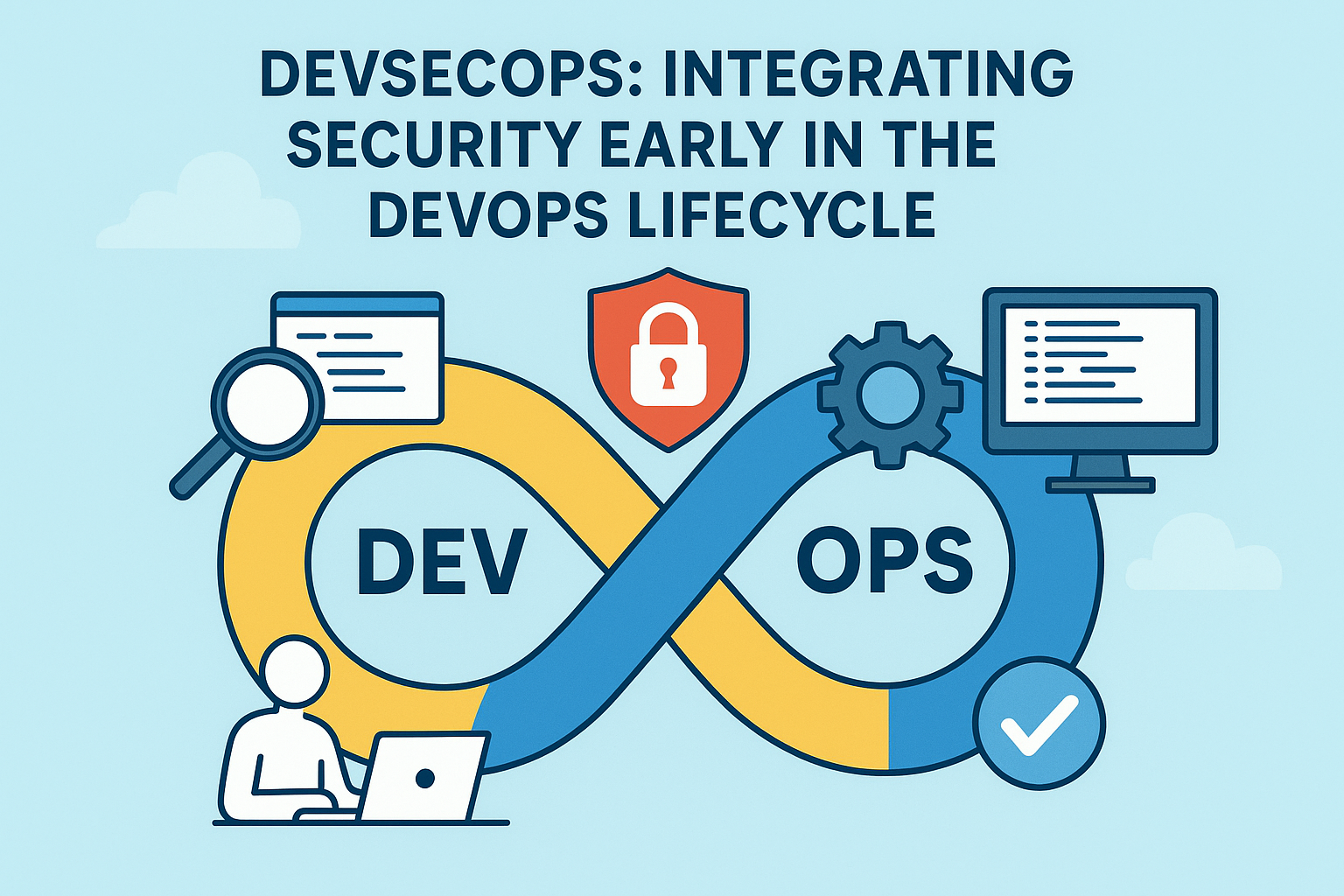Integrating Security Early in the DevOps Lifecycle

Introduction
Security used to be the final checkpoint before launching software—the team that frequently blocked releases and slowed everything down. Those days are fading fast. In today's digital landscape, waiting until the end to think about security is like installing a seatbelt after an accident.
DevSecOps transforms this approach entirely. Instead of treating security as a final gate, we're embedding it into every stage of development. It's about making security everyone's responsibility, not just an afterthought handled by a separate team.
This shift isn't optional anymore—it's essential for building resilient, trustworthy software in a world where cyber threats evolve daily.
The Problem with Traditional Security
Imagine your team spends three months building a major feature. Everything passes code review, tests are successful, and you're ready to launch. Then, two days before release, security discovers a critical vulnerability. Now you're scrambling to fix it, retesting everything, and definitely missing your deadline.
This scenario happens constantly in organizations worldwide, and it creates serious problems:
Expensive Fixes
Research shows that fixing security bugs in production costs up to 100 times more than catching them during development. That's not just money—it's time, reputation, and customer trust.
Slower Releases
When security becomes a last-minute bottleneck, it destroys agility. The core promise of DevOps—fast, iterative releases—collapses when security reviews take weeks.
Team Friction
Developers feel blocked by security's demands. Security teams feel overwhelmed reviewing everything under pressure. This creates conflict instead of collaboration.
Missed Vulnerabilities
Rushed security reviews inevitably miss issues. Those issues then become breaches, headlines, and damaged reputations.
DevSecOps solves this by making security continuous and collaborative rather than a last-minute obstacle.
What DevSecOps Really Means
DevSecOps isn't just DevOps with security added at the end. It represents a fundamental transformation in how we build software.
Cultural Transformation
Everyone owns security. Developers write secure code from day one. Operations teams ensure secure infrastructure. Security professionals become enablers who provide tools and guidance, not gatekeepers who say "no."
Technical Integration
Security checks are automated and built directly into your CI/CD pipeline. Every commit gets scanned. Every build gets tested. Every deployment follows security best practices—automatically.
This doesn't eliminate security teams. Instead, they evolve into strategic advisors who help teams understand risks and focus on complex problems requiring human expertise.
Core Components of DevSecOps
Automated Security Testing
Static Analysis (SAST)
Scans source code before it runs, catching vulnerabilities, coding errors, and security flaws. Tools like SonarQube or Semgrep run on every commit, giving developers instant feedback.
Dynamic Analysis (DAST)
Tests running applications from an attacker's perspective. Tools like OWASP ZAP integrate into CI/CD pipelines to find runtime vulnerabilities.
Dependency Scanning (SCA)
Analyzes third-party libraries and open-source components for known vulnerabilities. Since most applications contain more external code than original code, tools like Snyk or Dependabot are critical.
Infrastructure as Code Security
If you're defining infrastructure in code, that code needs security too. Tools like Checkov or Terrascan scan your Terraform or Kubernetes configurations for misconfigurations—catching overly permissive access, unencrypted storage, or exposed services before they reach production.
Container Security
Containers transformed deployment but introduced new risks. You need to:
- Scan images for vulnerabilities using tools like Trivy
- Implement image signing to ensure you're running trusted code
- Apply Kubernetes policies enforcing least privilege
- Monitor running containers for suspicious behavior
Secrets Management
Hard-coded passwords remain one of the most common security failures. Solutions like HashiCorp Vault or AWS Secrets Manager ensure credentials are stored securely, rotated regularly, and accessed only by authorized services.
Continuous Monitoring
Security doesn't end at deployment. You need:
- Log analysis to spot suspicious patterns
- Real-time attack detection
- Infrastructure monitoring for configuration changes
- Correlated security data across your entire system
Practical Implementation Strategy
Start Small
Don't implement everything at once. Choose one high-impact area—perhaps dependency scanning or secrets detection—and execute it well. Show results, build confidence, then expand.
Make Security Visible, Not Blocking
Initially, run security tools in advisory mode. They flag issues but don't stop deployments. This lets teams learn without feeling obstructed. As maturity grows, enforce stricter policies.
Provide Clear Feedback
Security tools generating cryptic errors get ignored or disabled. Choose tools with clear explanations and remediation guidance. Set up integrations that automatically create detailed tickets.
Create Security Champions
Identify developers interested in security and empower them as team champions. They bridge security and development, translating security requirements into practical implementations.
Measure Progress
Track meaningful metrics:
- Time to fix security issues
- Deployments passing security checks
- Vulnerabilities found in development vs. production
- Security test coverage
Foster Blameless Culture
When issues are discovered, focus on the process that allowed them through, not the individual. This encourages openness and learning over fear.
Overcoming Common Challenges
Tool Overload
Solution: Focus on coverage over quantity. Choose one excellent tool per critical area rather than five mediocre ones.
Alert Fatigue
Solution: Prioritize ruthlessly. Configure tools for high-severity issues first. Tune out false positives aggressively.
Slowing Velocity
Solution: Optimize scans for efficiency. Run tests in parallel. Accept that deep analysis might happen asynchronously.
Limited Expertise
Solution: Invest in training. Make learning resources accessible. Use tools with educational context.
Resistance to Change
Solution: Demonstrate value through pilots. Share success stories. Let results speak louder than mandates.
The Future Landscape
AI-Powered Security
Machine learning will identify anomalies, predict vulnerabilities, and suggest secure code alternatives with increasing sophistication.
Distributed Security
Security is spreading everywhere—from IDE plugins coaching developers to intelligent runtime protection stopping zero-day attacks.
Policy as Code
Security policies are becoming code themselves. Frameworks like Open Policy Agent let you define requirements that are version-controlled, tested, and automatically enforced.
Supply Chain Security
Software bill of materials (SBOM), artifact signing, and provenance tracking are becoming essential. Knowing exactly what's in your software is no longer optional.
Conclusion
DevSecOps represents a fundamental mindset shift. Security isn't the department that blocks progress—it's the enabler that lets you move faster with confidence.
By integrating security early and continuously, you catch issues when they're inexpensive to fix. You build security knowledge across teams. You deploy confidently knowing best practices are baked in, not bolted on.
The journey takes time. It requires cultural change, new tools, and new skills. But continuing to treat security as an afterthought is no longer viable.
Start where you are. Automate one security practice this week. Champion one tool. Have one conversation about shared ownership. Small, consistent steps lead to transformation.
The question isn't whether to adopt DevSecOps—it's how quickly you can shift before a security incident forces your hand.
In software security, you're either building it in from the start, or paying for it later.
